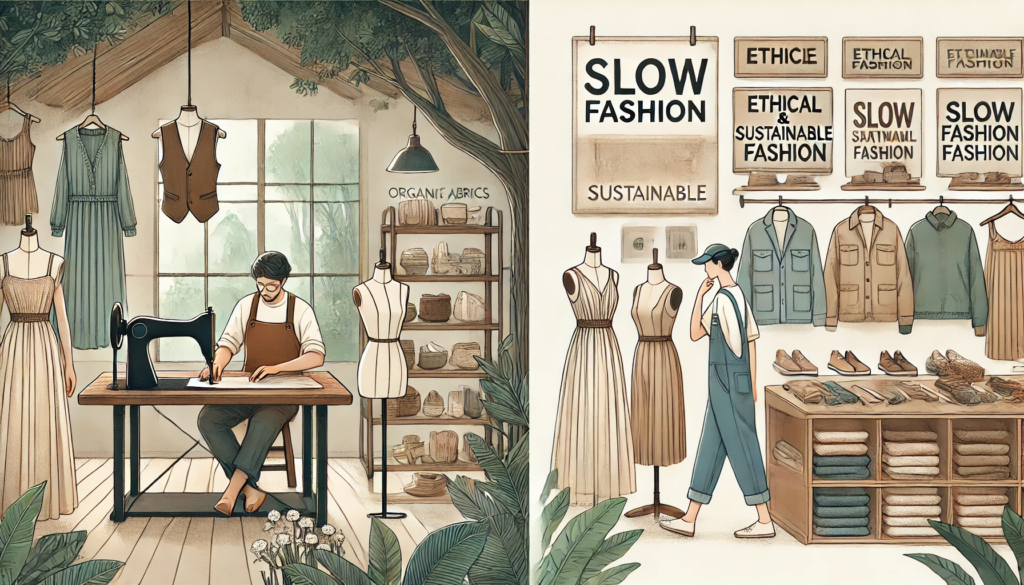Fashion production has increased by 100% in the last 15 years, according to the Ellen MacArthur Foundation. This alarming information shows the need for changes in the sector. Slow Fashion emerges as a sustainable and ethical alternative, countering the fast fashion model.
Slow Fashion values quality, durability, and local craftsmanship. It contrasts with the fast-paced production and disposal model of fast fashion. This approach not only reduces environmental impact but also strengthens the local economy and stimulates innovation.
Key Insights
- The movement emerged as a sustainable alternative to the fast fashion industry
- Prioritizes quality, durability, and the appreciation of local craftsmanship
- Reduces environmental impact and strengthens the local economy
- Encourages innovation and creativity in fashion production
- Promotes conscious consumption and the reuse of clothing
What is the Slow Fashion Movement?
The term “Slow Fashion” emerged in 2004 in England, inspired by the concept of “Slow Food”. The Concept movement values local production and the connection between producers and consumers. It also emphasizes socio-environmental awareness, the quality and durability of pieces, and the idea that “less is more”.
Origin and Principles of Slow Fashion
Principles include valuing the “genuine” of the region and more sustainable manufacturing processes. They also advocate for fair prices that reflect social and ecological costs. Slow Fashion distinguishes itself from the Fast Fashion model, which prioritizes mass production and low prices.
Contrast with Fast Fashion
The Fast Fashion system prioritizes quantity over quality, promoting excessive consumption and quick disposal of clothing. In contrast, Slow Fashion vs Fast Fashion encourages more conscious consumption, valuing sustainability in the fashion industry.
While Fast Fashion is characterized by rapid, large-scale production, Slow Fashion promotes smaller collections and greater transparency in production. It also focuses on extending the life of garments.
Brands like Zara, Topshop, and H&M, pioneers in Fast Fashion, offered affordable pieces inspired by haute couture. In contrast, Slow Fashion values sustainability, encouraging practices such as supporting the local market and using eco-friendly fabrics.
A Sustainable Response to the Fashion Industry
The movement emerges as a conscious and sustainable alternative to the fast fashion industry. While Fast Fashion is marked by resource waste, waste generation, and labor exploitation, Slow Fashion proposes a more careful and responsible approach at every stage of the production chain. This includes everything from raw material selection to final sale.
Slow Fashion Sustainability companies prioritize transparency about product origins, the appreciation of local production, and longer item lifespans. This contrasts with Sustainable Fashion Industry practices like greenwashing. Some Fast Fashion brands only update their packaging and invest in advertising without major changes in production.
Experts point out that the growth of small Slow Fashion brands in Brazil faces challenges such as unfair competition, high taxes, and large-scale foreign production. However, the movement aims to make fashion more accessible and inclusive for all audiences, including plus-sized people, non-binary individuals, and those with physical disabilities.

“The increased availability of inclusive sizes and models in Fast Fashion brands has attracted consumers who don’t easily find these options in Brazil. The need for a Slow pace that respects cycles and includes all bodies is a more supported alternative by fashion experts.”
In addition to product durability, Slow Fashion companies offer unique experiences for consumers, such as direct contact in ateliers. Education and awareness are also effective strategies for promoting changes in fashion consumption logic. They direct values and principles towards environmental sustainability.
The fashion industry is the second-largest environmental polluter, with high rates of carbon emissions, water consumption, and waste generation. In this context, it emerges as a conscious and sustainable response. It encourages practices such as using renewable raw materials, promoting reverse logistics, and adopting technologies that maximize efficiency and product quality.
Implementing Slow Fashion can drive the fashion industry towards a more sustainable future. It meets the growing demand for ethical and eco-friendly fashion.
Benefits
The Slow Fashion movement brings important benefits to consumers, the environment, and society. Let’s explore the main positive aspects of this sustainable fashion philosophy.
Local Production and Appreciation of Craftsmanship
A striking feature of Slow Fashion is the appreciation of local production and regional craftsmanship. Supporting local brands and entrepreneurs strengthens the community’s economy. This reduces transportation costs and carbon emissions while valuing manual and artisanal work.
Reduction of Environmental Impact
Slow Fashion also reduces environmental impact. The fashion industry is highly polluting, generating water waste and gas emissions. Sustainable practices, such as using eco-friendly materials and prioritizing durability, help mitigate these impacts.
Studies show that Slow Fashion is revolutionizing fashion. It promotes sustainability, ethics, and conscious consumption, benefiting consumers, workers, and the environment. Brands adopting this movement have seen an 80% increase in revenue.
Slow Fashion also creates local jobs by stimulating craftsmanship and local production. It is associated with ethical work practices, ensuring fair wages and dignified conditions for professionals.
In summary, Slow Fashion is a sustainable and conscious alternative in fashion. It promotes benefits in local production, appreciation of craftsmanship, reduction of environmental impact, and sustainability. This philosophy is changing how we consume and think about fashion.
The Profile of Slow Fashion Consumers in Ceará
Slow fashion consumers in Ceará prefer versatile and durable pieces. They shy away from fast fashion, which values exclusivity and rapid trends. A local study shows that these consumers seek clothing that lasts several seasons, valuing quality and extended lifespan.
In contrast, people in Ceará opt for affordable and less exclusive clothing. This is more common in rural areas, where proximity to local craftsmanship influences this choice.
Finally, the Slow Fashion movement aligns with the growing awareness of sustainability in Brazil. It is an alternative that values ethical and eco-friendly practices, reflecting the values of an increasingly conscious society.
Sources:
- Fashion Revolution. (2023). “The True Cost of Fast Fashion”.
- Ellen MacArthur Foundation. (2023). “A New Textiles Economy: Redesigning Fashion’s Future”.
- Fashion United. (2023). “Slow Fashion: A Growing Trend”.
